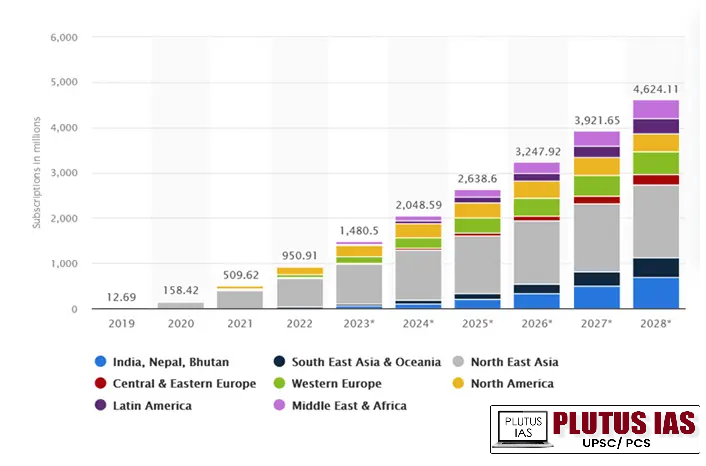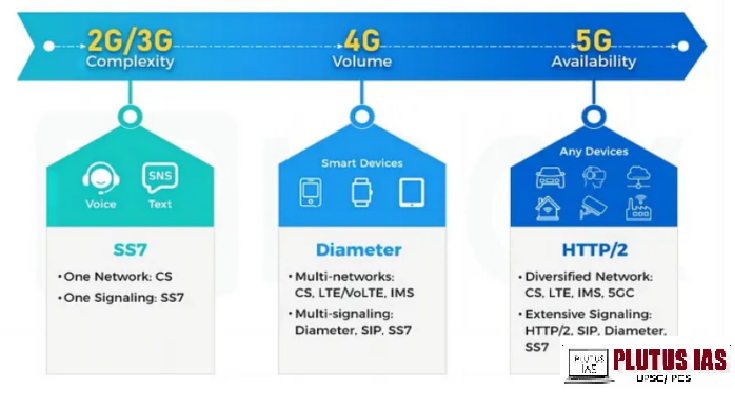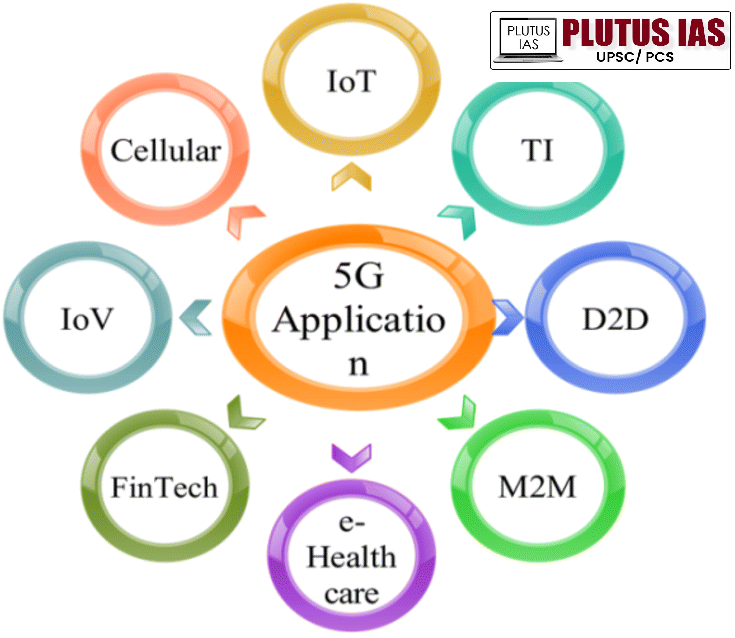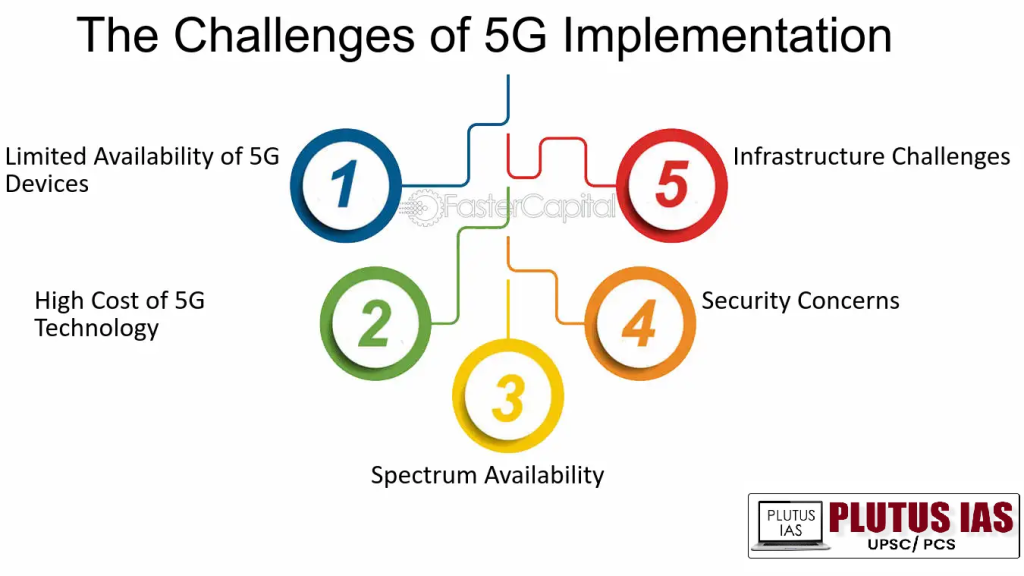13 Dec 5G Technology: Accelerating Innovation and Connectivity Worldwide
SYLLABUS MAPPING:
GS-3-Science and technology-5G Technology: Accelerating Innovation and Connectivity Worldwide
FOR PRELIMS:
What is 5G technology? Latency of 5G technology and various govt initiatives.
FOR MAINS:
Application of 5G Technology in Various Fields, Challenges Associated with the Rollout of 5G Technology in India, and Major Solutions to Address These Challenges.
Why in the news?
Evolution of communications technology:
1. 1G to 5G
1G: The first generation of mobile networks, using analogue signals, focused on voice communication but offered limited capacity and poor sound quality.
2G: Introduced digital technology, improving voice quality and enabling text messaging (SMS) and basic data services.
3G: Brought mobile internet with faster data speeds, enabling video calls, browsing, and multimedia.
4G: Delivered high-speed internet, supporting HD video streaming, mobile apps, and high-bandwidth services.
5G: Provides ultra-fast speeds, low latency, and high capacity, transforming industries with advanced technologies like IoT and autonomous vehicles.
2. LTE to VoLTE
LTE (Long-Term Evolution): A 4G standard that enhances data speeds for mobile internet but originally routed voice calls through older networks (2G/3G).
VoLTE (Voice over LTE): Enables voice calls over the LTE network, improving call quality, reducing setup times, and supporting simultaneous voice and data services, offering a seamless user experience.

5-G Technology:
5G technology will revolutionize network architecture with the introduction of 5G New Radio (NR), covering spectrums not available in 4G. New antennas using massive MIMO technology will enable simultaneous data transfer, boosting capacity. 5G will also support a converged network combining licensed and unlicensed wireless technologies, increasing available bandwidth. The network will be software-defined, with functions managed through software, making it more agile and flexible. 5G will enable network slicing, allowing customization of network functionality based on specific users or devices. Additionally, 5G will enhance digital experiences through machine learning (ML)-enabled automation. With the demand for ultra-fast response times, 5G networks will incorporate ML, deep learning, and AI to optimize traffic management and reduce costs, improving the overall user experience.

4G and 5G Comparisons:
| Feature | 4G | 5G |
|---|---|---|
| Data Speed | Up to 1 Gbps (Theoretical max) | Up to 20 Gbps (Theoretical max) |
| Latency | Around 30-50 milliseconds | Around 1 millisecond |
| Bandwidth | 100 MHz (up to 1 GHz) | 100 MHz to 1 GHz (or higher) |
| Network Capacity | Lower capacity, limited device connections | Higher capacity, supporting millions of devices per square kilometre |
| Applications | Mobile broadband, HD Video streaming, VoIP | IoT, smart cities, autonomous vehicles, immersive AR/VR, high-speed broadband |
| Connection Density | Around 2,000 devices per square kilometre | Over 1 million devices per square kilometre |
| Technology | OFDMA, MIMO | Massive MIMO, Beamforming, Network Slicing |
| Energy Efficiency | Moderate | Improved energy efficiency, optimized for IoT devices |
| Deployment | Widely deployed | In the process, with nationwide rollouts underway |
| Use Case | Mobile internet, Video streaming, apps | Autonomous vehicles, smart cities, remote healthcare, industrial IoT |
Applications of 5G technology:
1. Mobile Broadband: 5G offers faster data speeds and lower latency, which allows for smoother online gaming, streaming high-definition videos, and downloading and uploading large files.
2. Internet of Things (IoT): 5G’s low latency and high network capacity allow for a large number of connected devices, which is important for the widespread adoption of IoT in smart homes, smart cities, and industrial IoT.
3. Mission-Critical Communications: 5G provides reliable and low-latency communication for critical applications such as emergency services, public safety, and mission-critical communications.
4. Smart Cities: 5G can be used for a range of smart city applications, including traffic control, instant weather updates, local broadcasting, energy management, and emergency response.
5. Healthcare: 5G can facilitate high-quality telemedicine services, allowing for remote consultations, real-time monitoring of patients, and tele-treatment.
6. Agriculture: 5G technology can be used to gather data from sensors installed in fields, soil, silos, and irrigation systems to optimize fertilizer, water, and pesticide applications.
7. Manufacturing: 5G can be used to control and analyze industrial processes with an unprecedented degree of precision.
8. Remote Education: 5G’s increased speed, better connectivity, and higher reliability can help boost remote education for students.
9. Drone Operation: 5G can provide high-speed wireless internet connectivity for drone operation in a wide range of applications.

Challenges in implementation:
1. Limited Availability of 5G Devices: The adoption of 5G technology is hindered by the limited availability of 5G devices. While some manufacturers have released 5G-enabled smartphones, they remain relatively expensive and not widely accessible, slowing down overall adoption.
2. High Cost of 5G Technology: The implementation of 5G requires substantial investment in infrastructure, which can lead to higher costs for consumers. The expense of 5G-enabled devices further complicates adoption for many users.
3. Spectrum Availability: 5G networks demand a significant amount of spectrum, but availability is limited. Intense competition among telecom companies for access can delay the deployment of 5G networks in various regions.
4. Security Concerns: 5G networks introduce new security challenges. Their increased connectivity may make them more susceptible to cyber attacks, necessitating robust security protocols to protect users.
5. Infrastructure Challenges: Establishing the infrastructure for 5G involves deploying a dense network of small cell sites, particularly in urban areas. This process may face resistance from local communities concerned about the aesthetic impact of these installations.

Way forward:
1. Expanding Device Availability: To encourage widespread adoption, telecom companies and device manufacturers should collaborate to increase the availability of affordable 5G-enabled devices, making them accessible to a broader audience.
2. Investment in Infrastructure: Ongoing investment in 5G infrastructure is crucial for reliable coverage in both urban and rural areas. Governments and private sectors must work together to navigate challenges related to deployment, including regulatory approvals and community opposition.
3. Spectrum Management: Efficient spectrum allocation is essential for seamless 5G services. Governments should consider auctioning additional spectrum or repurposing existing frequencies to ensure telecom providers have adequate access.
4. Enhanced Security Protocols: To mitigate security risks, robust encryption and advanced security measures must be integrated into 5G networks. Collaboration among governments, telecom providers, and cybersecurity experts is vital to protect against potential threats.
5. Public Awareness and Support: Raising awareness about the benefits of 5G and addressing public concerns—particularly regarding small cell infrastructure—will facilitate faster rollout. Engaging local communities and highlighting the long-term advantages of 5G can foster broader support.
Conclusion
The successful launch of 5G services marks a significant milestone in India’s digital transformation. While there are challenges, including device availability, infrastructure demands, and security risks, the potential benefits of 5G in revolutionizing industries like healthcare, agriculture, and manufacturing are immense. With continued investment, careful management of resources, and collaboration across sectors, 5G can drive economic growth, improve the quality of life, and position India as a global leader in next-generation technology. The way forward involves addressing these challenges strategically while capitalizing on the transformative power of 5G to unlock new opportunities across various sectors.
Download Plutus IAS Current Affairs (ENG) 13th Dec 2024
Prelims Question:
Q. Which of the following is a primary application of 5G technology?
1. Improved voice communication quality
2. High-speed internet for gaming and video streaming
3. Satellite communication for weather forecasting
4. Wireless power transmission
Choose the correct option:
A. 1 and 2
B. 2 and 3
C. 2 and 4
D. 1 and 4
Answer: B
Mains Question:
Q. Discuss the challenges and potential of 5G technology in India. What steps should be taken to address these challenges and harness the benefits of 5G?
(250 words, 15 marks)



No Comments